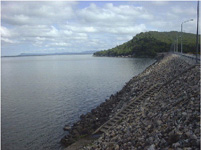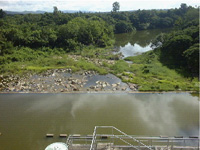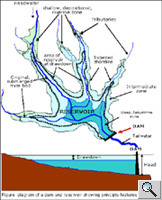13.2 DAMS AND RESERVOIRS
Functioning of dams and reservoirs / The ecological effects of dams and reservoirs
For much of recorded history, humans have been engaged
in a struggle to tame the flows of large rivers in order to provide the
desired amount of water in the right place at the right time. The most
conspicuous means by which this has been attempted and, at times, achieved,
is by the construction of dams across rivers to control flow and store
water. Almost all major river systems are affected, to some extent, by
dams. The main period for dam building started in the 1950s, and is continuing
today as an essential part of economic and social development. Major dams
are generally very costly structures involving heavy engineering. For
example, the Three Gorges Dam on the Yangtze River in China, currently
under construction, is the largest dam in the world. Dams bring many benefits,
but their effects on humans (through displacement) and the natural environment
can be severe. For this reason, any new proposals for dam building have
to be examined carefully to assess their potential impacts on human society
and on the biodiversity of the river systems on which they are built.
This is especially true where a series of dams – known as a cascade of
dams – are built along the course of a river.
Reasons for Dam Construction--
Dams are built for a number of reasons:
• Hydroelectric power generation – the water stored behind the dam is used to drive turbines that are connected to electrical generators.
• Flood control – the dam is used to store the water coming down river during the floods, and to release it over a period of time at a later date, so that human habitation or agricultural lands are not flooded.
• Agriculture – the water stored behind the dam is released to provide water to crops during the dry season or in times of drought and water scarcity.
• Water transfers – the water stored behind a dam is discharged through pipelines or canals to another river system to make up for shortfalls in flow in the receiving river. The receiving river usually also has a stabilizing dam so that the transferred water can be stored until it is required. This water is then used for domestic, agricultural or industrial purposes.
• Domestic water supply – the water stored behind dams is released into domestic supply systems, usually for towns and cities, over a period of time to ensure a constant supply of water for cooking, drinking washing, etc.
• Navigation – dams are used to regulate the fall of the river, especially in areas of high slope so that boats can pass. In these cases the dams are associated with navigation lock systems. Dams are also used to retain water that can be released in the dry season to maintain sufficient depth for navigation.
Dams may be used to fulfill more
than one of these functions. However, dams used for power generation are
likely to be very different in design from those designed for flood control
or navigation. Power generation requires a consistent regular release
of water, whereas the demand from irrigation tends to be highly seasonal.
Functioning
of Dams and Reservoirs--
Dams consist of two main elements:
The dam wall is usually a concrete, rock or earth filled barrier placed across a river to control the passage of water. To minimize cost and maximize engineering efficiency, dams are usually built at narrow points in the river such as gorges, where they can be firmly anchored to the banks. From the fisheries point of view, dams can be classified as high dams, which cannot be passed by standard fish ladders, and low dams, which can be passed by fish ladders (see Section 12). Lower structures are known as weirs, and these may be only a few meters in height.
The reservoir or impoundment is the water body retained behind the dam. Reservoirs may be extremely large, forming extensive lakes. Run-of-the-river dams, which constrain the flow of the river without retaining a large volume of water behind the dam structure, usually inundate little more than the original river channel. Run-of-the-river dams are generally used for hydroelectric power generation.
The reservoir behind the dam is generally designed
to have a high water level and a low water level. The difference between
the two levels is called the drawdown zone. The drawdown multiplied
by the area of the reservoir is known as the useable volume. The useable
volume is the amount of water available for power generation, irrigation
or domestic purposes.
At the end of the rainy season, the dam is generally full, and as the
dry season progresses the water level in the reservoir drops to its
minimum design level. Where the dam is intended for flood protection,
the dam is generally emptied before the wet season, and the useable
volume represents the capacity of the dam to absorb wet season flow.
If more water arrives than the dam can hold, it is released via a spillway
into the river channel below the dam.
 |
 |
 |
The water used for power generation
or flood control is also discharged into the tailwaters downstream of
the dam, but water used for water transfers, irrigation and domestic
supply and agriculture is drawn from the river, which results in a decline
in flow downstream. In extreme cases, this may lead to drying of the
channel; in almost all instances, ecological effects result from the
change in timing or magnitude of flows caused by dams.
The ecological effects of dams and reservoirs--
Overall effects on river ecology
The most obvious effect of dams is the conversion of an environment
that is characterised by unidirectional (one-way) flow of water, to
one where there is little or no flow. The result is that the plants
and animals adapted to natural flowing conditions of a river may be
unable to survive; by contrast, those adapted to standing waters may
thrive, and it is under such conditions that certain floating plants
(such as water hyacinth; see Section 6) can become a nuisance. Other
species that may be viewed as pests, such as certain species of snails
that act as intermediate hosts for parasites of humans (see Section
8), may proliferate in the standing waters of reservoirs.

Water flowing into a reservoir from headwater streams
slows and deposits its suspended load. This load includes inorganic
material, which falls to the reservoir bed as silt, but also suspended
organic particles – mainly detritus in the form of FPOM (see Section
7). The deposition of silt in the reservoir means that, gradually, the
basin will become filled and the useable volume of water will decline.
This has the effect of limiting the life span of the reservoir, and
is an especially important consideration when dam construction is planned
along a river that carries a high load of suspended solids. Reservoirs
generally store water for a period of time. In large reservoirs, this
may be for several months but in run-of-the-river dams, the water passes
through at a similar rate to water in the undammed river.
As water enters a reservoir from the headwater streams, the water slows
down and deposits its suspended load. Thus the upper portion of the
reservoir becomes progressively marshier. The deposition of silt in
the reservoir (or natural lake) means that any lake has a limited life
and eventually will become so filled with silt as to be unable to fulfil
the function for which it was built. Experience has shown that the rate
with which most dams fill with silt exceeds initial estimates and as
a result the useful life of the dam is reduced. In some cases, the economic
justification for dam construction is not met due to its reduced life
span.